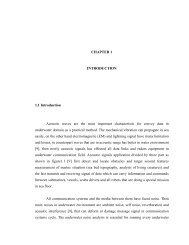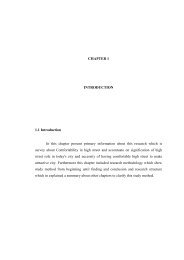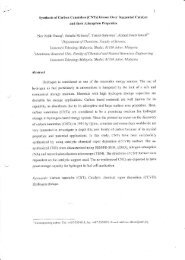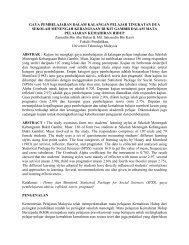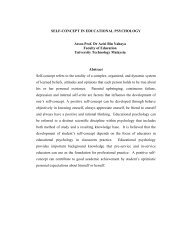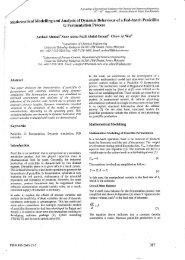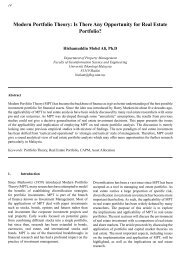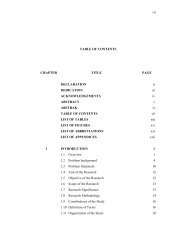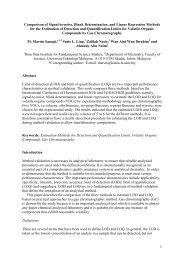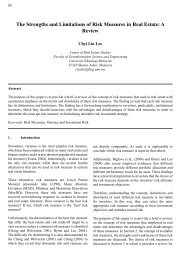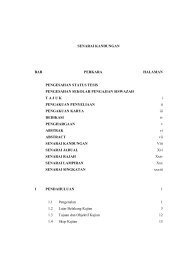Rational approach to the selection of conditions for diastereomeric ...
Rational approach to the selection of conditions for diastereomeric ...
Rational approach to the selection of conditions for diastereomeric ...
Create successful ePaper yourself
Turn your PDF publications into a flip-book with our unique Google optimized e-Paper software.
F. C. Ferreira et al. / Tetrahedron: Asymmetry 17 (2006) 1337–1348 1339<br />
Table 1. Model parameters<br />
Entry Amine PEA PPI2<br />
1 Ka 1 (M 1 ) 10 5.2 10 5.2<br />
2 Ka 2 (M 1 ) 10 6.6 10 6.6<br />
3 Ka amine (M 1 ) 10 8.4 10 7.5<br />
4 Kd AS =Kd AR (M) 10 5 10 5<br />
5 Kd AS2 =Kd AR2 (M) 10 10 10 10<br />
6 Ks AR (mM) 2.8 361.0<br />
7 Ks AS (mM) 4.7 12.0<br />
8 Ks AR2 (mM) 387.3 14.0<br />
9 Ks AS2 (mM) 28.3 11.0<br />
10 [Amine] 0 (mM) 176.0 280.0<br />
meric salts as a function <strong>of</strong> C employed. For both models,<br />
<strong>the</strong> calculated results (Fig. 2a and b) show that <strong>for</strong> C < 0.5<br />
(half equivalent method), only <strong>the</strong> neutral <strong>diastereomeric</strong><br />
salts are <strong>for</strong>med. Under this condition, virtually all <strong>the</strong><br />
resolving agent is consumed by <strong>the</strong> <strong>for</strong>mation <strong>of</strong> <strong>diastereomeric</strong><br />
salts (AS2 t =2ÆCÆS 0 and AR2 t =2ÆCÆR 0 ), whereas a<br />
significant part <strong>of</strong> <strong>the</strong> amine is left unreacted in solution<br />
(S t,ML = S 0 Æ(1 2ÆC) or R t,ML = R 0 Æ(1 2ÆC)). For 0.5 <<br />
C < 1.5, a mixture <strong>of</strong> neutral and acid salts is <strong>for</strong>med.<br />
Finally, <strong>for</strong> C > 1.5 only <strong>the</strong> acidic salts (AS and AR) are<br />
<strong>for</strong>med, with virtually all <strong>the</strong> amine consumed by <strong>the</strong><br />
<strong>for</strong>mation <strong>of</strong> <strong>the</strong>se salts, and <strong>the</strong> resolving agent added in<br />
excess is left unreacted in solution. Notice that <strong>the</strong> calculated<br />
pr<strong>of</strong>iles are equal <strong>for</strong> <strong>the</strong> two neutral salts and <strong>for</strong><br />
<strong>the</strong> two acidic salts. This is a direct consequence <strong>of</strong> <strong>the</strong><br />
assumption that <strong>the</strong>re is no chiral recognition in solution<br />
(Assumption 5, see Section 4).<br />
A higher solubility limit (Ks) was found <strong>for</strong> <strong>the</strong> (R)-neutral<br />
salt in <strong>the</strong> case <strong>of</strong> PEA (Table 1, entry 8) and <strong>for</strong> <strong>the</strong><br />
(R)-acid salt in <strong>the</strong> case <strong>of</strong> PPI2 (Table 1, entry 6). There<strong>for</strong>e<br />
it is expected that <strong>the</strong> resolution <strong>of</strong> PEA is based on<br />
<strong>the</strong> differential solubility <strong>of</strong> neutral salts (Ks AR2 and<br />
Ks AS2 ), whereas <strong>the</strong> resolution <strong>of</strong> PPI2 is based on <strong>the</strong><br />
differential solubility <strong>of</strong> acidic salts (Ks AR and Ks AS ).<br />
The calculated ee’s shown in Figure 2c and d illustrate this,<br />
with <strong>the</strong> highest predicted ee’s at C < 0.5 in <strong>the</strong> case <strong>of</strong> PEA<br />
(neutral salt <strong>for</strong>mation), and above C > 1.5 in <strong>the</strong> case <strong>of</strong><br />
PPI2 (acidic salt <strong>for</strong>mation).<br />
The calculated data in Figure 2a and b show a significant<br />
impact <strong>of</strong> <strong>the</strong> acid–base equilibria <strong>for</strong> <strong>the</strong> region <strong>of</strong> acidic<br />
Concentration (M)<br />
(a)<br />
0.16<br />
0.14<br />
0.12<br />
0.10<br />
0.08<br />
0.06<br />
0.04<br />
0.02<br />
Neutral<br />
Salts<br />
AR&AS (Model I)<br />
AR2&AS2 (Model I)<br />
AR&AS (Model II)<br />
AR2&AS2 (Model II)<br />
0.00<br />
0 0.5 1 1.5 2<br />
100<br />
Γ (mol.mol -1 )<br />
Acidic<br />
Salts<br />
AR&AS<br />
(Model II)<br />
AR&AS<br />
(Model I)<br />
AR2&AS2<br />
(Model I)<br />
AR2&AS2<br />
(Model II)<br />
racemic amine: PEA<br />
Concentration (M)<br />
(b)<br />
0.35<br />
0.30<br />
0.25<br />
0.20<br />
0.15<br />
0.10<br />
At (Model I)<br />
Rt (Model I)<br />
St (Model I)<br />
pH (Model II)<br />
0.05<br />
At<br />
2<br />
(Model II)<br />
0.00<br />
0<br />
0 0.5 1 1.5 2<br />
100<br />
Rt&St<br />
(Model I &<br />
Model II)<br />
pH<br />
(Model II)<br />
At<br />
(Model I)<br />
Γ (mol.mol -1 )<br />
racemic amine:PPI2<br />
At (Model II)<br />
Rt (Model II)<br />
St (Model II)<br />
12<br />
10<br />
8<br />
6<br />
4<br />
pH<br />
50<br />
50<br />
e.e. (%)<br />
0<br />
-50<br />
0 0.5 1 1.5 2<br />
Γ (mol.mol -1 )<br />
e.e. (%)<br />
0<br />
-50<br />
0 0.5 1 1.5 2<br />
Γ (mol.mol -1 )<br />
(c)<br />
-100<br />
e.e. (Model I)<br />
e.e. (Model II)<br />
e.e. ML (Model II) e.e. ML (Model I)<br />
(d)<br />
-100<br />
e.e. (Model I)<br />
e.e. ML (Model I)<br />
e.e. (Model II)<br />
e.e. ML (Model II)<br />
Figure 2. Model results comparison. Models I and II, respectively, neglect and account <strong>for</strong> acid–base equilibrium. Results in (a) and (b) were calculated <strong>for</strong><br />
[amine] 0 = 280 mM, but neglecting <strong>the</strong> precipitation <strong>of</strong> any salt, that is, a value <strong>of</strong> zero was fixed <strong>for</strong> W AS , W AR , W AS2 , W AR2 . Results in (c) and (d) were<br />
calculated using input parameters given in Table 1 <strong>for</strong> <strong>the</strong> PEA and PPI2 amine–DTTA systems, respectively.



